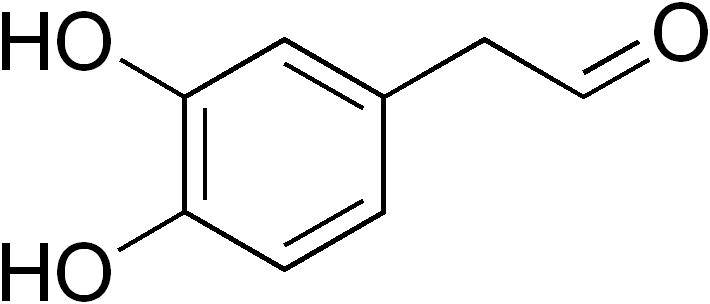Catecholaldehyde Hypothesis on:
[Wikipedia]
[Google]
[Amazon]
 The catecholaldehyde hypothesis is a
The catecholaldehyde hypothesis is a
 The catecholaldehyde hypothesis is a
The catecholaldehyde hypothesis is a scientific theory
A scientific theory is an explanation of an aspect of the universe, natural world that can be or that has been reproducibility, repeatedly tested and has corroborating evidence in accordance with the scientific method, using accepted protocol (s ...
positing that neurotoxic
Neurotoxicity is a form of toxicity in which a biological, chemical, or physical agent produces an adverse effect on the structure or function of the central and/or peripheral nervous system. It occurs when exposure to a substance – specifical ...
aldehyde
In organic chemistry, an aldehyde () (lat. ''al''cohol ''dehyd''rogenatum, dehydrogenated alcohol) is an organic compound containing a functional group with the structure . The functional group itself (without the "R" side chain) can be referred ...
metabolite
In biochemistry, a metabolite is an intermediate or end product of metabolism.
The term is usually used for small molecules. Metabolites have various functions, including fuel, structure, signaling, stimulatory and inhibitory effects on enzymes, c ...
s of the catecholamine
A catecholamine (; abbreviated CA), most typically a 3,4-dihydroxyphenethylamine, is a monoamine neurotransmitter, an organic compound that has a catechol (benzene with two hydroxyl side groups next to each other) and a side-chain amine.
Cate ...
neurotransmitter
A neurotransmitter is a signaling molecule secreted by a neuron to affect another cell across a Chemical synapse, synapse. The cell receiving the signal, or target cell, may be another neuron, but could also be a gland or muscle cell.
Neurotra ...
s dopamine
Dopamine (DA, a contraction of 3,4-dihydroxyphenethylamine) is a neuromodulatory molecule that plays several important roles in cells. It is an organic chemical of the catecholamine and phenethylamine families. It is an amine synthesized ...
and norepinephrine
Norepinephrine (NE), also called noradrenaline (NA) or noradrenalin, is an organic compound, organic chemical in the catecholamine family that functions in the brain and human body, body as a hormone, neurotransmitter and neuromodulator. The ...
are responsible for neurodegenerative disease
A neurodegenerative disease is caused by the progressive loss of neurons, in the process known as neurodegeneration. Neuronal damage may also ultimately result in their death. Neurodegenerative diseases include amyotrophic lateral sclerosis, mul ...
s involving loss of catecholaminergic
Catecholaminergic means "related to catecholamines". The catecholamine neurotransmitters include dopamine, epinephrine (adrenaline), and norepinephrine (noradrenaline).
A catecholaminergic agent (or drug) is a chemical which functions to directly ...
neuron
A neuron (American English), neurone (British English), or nerve cell, is an membrane potential#Cell excitability, excitable cell (biology), cell that fires electric signals called action potentials across a neural network (biology), neural net ...
s, for instance Parkinson's disease
Parkinson's disease (PD), or simply Parkinson's, is a neurodegenerative disease primarily of the central nervous system, affecting both motor system, motor and non-motor systems. Symptoms typically develop gradually and non-motor issues become ...
. The specific metabolites thought to be involved include 3,4-dihydroxyphenylacetaldehyde (DOPAL) and 3,4-dihydroxyphenylglycolaldehyde (DOPEGAL), which are formed from dopamine and norepinephrine by monoamine oxidase
Monoamine oxidases (MAO) () are a family of enzymes that catalyze the oxidation of monoamines, employing oxygen to clip off their amine group. They are found bound to the outer membrane of mitochondria in most cell types of the body. The fi ...
, respectively. These metabolites are subsequently inactivated and detoxified by aldehyde dehydrogenase
Aldehyde dehydrogenases () are a group of enzymes that catalyse the oxidation of aldehydes. They convert aldehydes (R–C(=O)) to carboxylic acids (R–C(=O)). The oxygen comes from a water molecule. To date, nineteen ALDH genes have ...
(ALDH). DOPAL and DOPEGAL are monoaminergic neurotoxin
A monoamine neurotoxin, or monoaminergic neurotoxin, is a drug that selectively damages or destroys monoaminergic neurons. Monoaminergic neurons are neurons that signal via stimulation by monoamine neurotransmitters including serotonin, dopamine ...
s in preclinical models and inhibition
Inhibitor or inhibition may refer to:
Biology
* Enzyme inhibitor, a substance that binds to an enzyme and decreases the enzyme's activity
* Reuptake inhibitor, a substance that increases neurotransmission by blocking the reuptake of a neurotransm ...
of and polymorphisms in ALDH are associated with Parkinson's disease. The catecholaldehyde hypothesis additionally posits that DOPAL oligomerizes with α-synuclein
Alpha-synuclein (aSyn) is a protein that in humans is encoded by the ''SNCA'' gene. It is a neuronal protein involved in the regulation of synaptic vesicle trafficking and the release of neurotransmitters.
Alpha-synuclein is abundant in the bra ...
resulting in accumulation of oligomerized α-synuclein (i.e., synucleinopathy
Synucleinopathies (also called α-Synucleinopathies) are neurodegenerative diseases characterised by the abnormal accumulation of aggregates of alpha-synuclein protein in neurons, nerve fibres or glial cells. There are three main types of synucle ...
) and that this contributes to cytotoxicity
Cytotoxicity is the quality of being toxic to cells. Examples of toxic agents are toxic metals, toxic chemicals, microbe neurotoxins, radiation particles and even specific neurotransmitters when the system is out of balance. Also some types of d ...
.
See also
*Amyloid hypothesis
The biochemistry of Alzheimer's disease, the most common cause of dementia, is not yet very well understood. Alzheimer's disease (AD) has been identified as a proteopathy: a protein misfolding disease due to the accumulation of abnormally folded am ...
References
Aging-associated diseases Biological hypotheses Catecholamines Dopamine Lewy body dementia Monoaminergic neurotoxins Neurodegenerative disorders Parkinson's disease Senescence Unsolved problems in neuroscience {{Neuroscience-stub